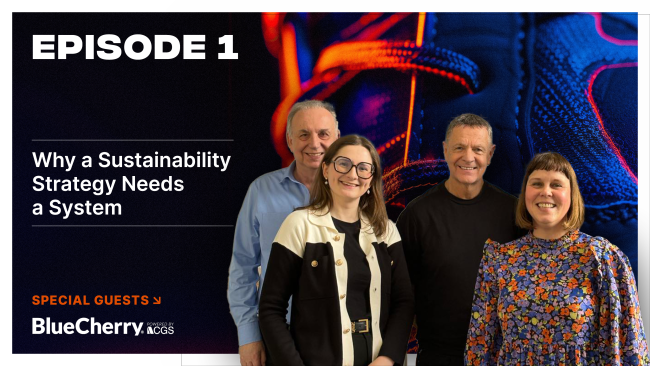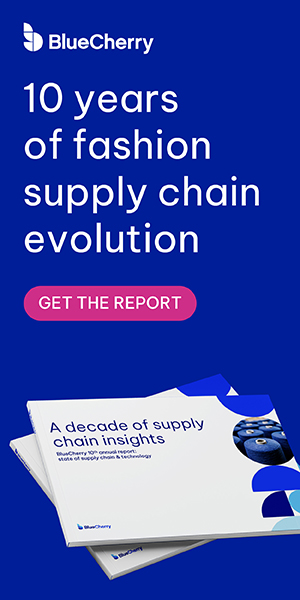Topics
Why a Sustainability Strategy Needs a System

We’re a partner of the British Footwear Association (BFA), and we were delighted to make a special appearance on the trade body’s inaugural podcast a few weeks back.
BlueCherry’s managing director Tony Mather joined BFA business development manager, Polly Lythall, to discuss all things sustainability – a crucial subject for the footwear (and wider fashion) industry to engage with in 2024. Tony argued you can’t have a sustainability strategy without a system – and that is, of course, where our technology can come in to help brands.
BlueCherry Enterprise Suite is an end-to-end supply chain management solution which supports the needs of high-growth organisations operating in consumer lifestyle products, retail, and apparel – including footwear businesses – and can play a role in getting data in order, which is essential for any sustainability strategy to run successfully.
5 key takeaways from the podcast
1. Time to digitise: Talking to Polly, Tony advised footwear brands to “check your process, document your process, automate your process”, saying BlueCherry is on hand to help here if businesses require it. Fundamentally this is about digitising your processes on one central platform, which will be crucial for brands and retailers in the coming years as they will increasingly be legislated to report on many areas of sustainability.
Having the base data in one place – be it sourcing information, material composition details, or information about suppliers’ practices – means retailers and brands can be more organised as legislation inevitably evolves and multiplies over time, argued Tony.
2. Meeting sustainability standards requires a system: With retailers and brands now more regularly needing to select raw materials that comply with environmental standards, a PLM can be used to keep information about sustainability criteria up to date. This helps organisations make the most sustainable choices going forward, according to Tony.
For footwear, specifically, this might be detail such as which kind of sole a product has, and where the trim comes from. Tony said tracking these things through a system – rather than having to flick through multiple spreadsheets on different work colleagues’ individual computers – is vital for making sustainability progress in 21st century commerce.
3. Sampling needs simplifying: Using a PLM can help fashion and footwear retailers cut down on waste from sampling.
Tony noted that using a system such as BlueCherry’s PLM enables organisations to visualise products, communicate with suppliers, and replace physical prototypes with virtual samples thanks to how it can seamlessly be linked to the latest 3D tools and technology.
Fashion and footwear companies are often global entities with different departments and supplier bases across the world. Using an accessible system to talk about, showcase, and tweak product development processes can be a quickfire way to getting designs right the first time and reducing surplus sampling waste in the fashion and footwear supply chain.
4. Democratisation of data: For fashion and footwear retailers and brands to be successful, there is a reliance on multiple components of the supply chain doing their job thoroughly and efficiently. Providing a system that is accessible to each of those tiers of the supply chain is vital in reducing the number of early errors that occur and can cause major problems later down the line.
The podcast discussed how important information comes from design teams as they are bringing products through, so they need a chance to document their work and draw on company-wide information in order to do their jobs properly. “Everyone can add their bit,” was the comment made – the ERP and PLM is not just for senior management usage, all departments need their own access to build transparency across a business.
All sorts of benefits arise. Not only does it make different departments’ working lives easier if they have a system, but management will have a clearer view of productivity or technical problems that need to be addressed.
5. Footwear brands have a vision but no guide: Polly suggested when it comes to sustainability strategy, “lots of members have ideas and a vision but can’t put it in order” – which is another argument for why sustainability strategy needs a system.
She argued some BFA members have been “kicking the can down the road” in terms of starting to develop and improve sustainability strategy because it can seem “insurmountable”. She added that often the task of leading this agenda is given to someone who already has multiple responsibilities across several departments.
But as Tony said, they just need to begin somewhere. “Baby steps,” can lead to more substantial progression, he said, but it all starts with recording data in a centralised way, so measurement and reporting can begin – and that is relevant to small enterprises right the way up to multi-billion-pound organisations.
Start now was the message from the podcast and gain a view on government papers – be they country-specific or regional such as the raft of suggested legislation filtering through various European Union departments – to understand the direction of travel.
Listen to the full podcast HERE
BFA Sustainability Summit
Lots of the themes we discussed on the podcast cropped up as leaders in the footwear sector met at the BFA Sustainability Summit in April. Speakers from renowned brands such as Nike, Dr. Martens, River Island, Vivobarefoot, and FAIRFAX & FAVOR, took to the stage in Birmingham to share their work and their thinking.
The summit covered vital topics such as designing in sustainability and material selection, as well as adopting lifecycle analysis and considerations around leather – which is a difficult material when it comes to improving sustainability.
The general mood of the conference was one of hope for the future, while there was positivity that the footwear industry is laser focused on tackling some difficult subjects – and doing so collaboratively. We look forward to hearing about the industry’s progress at next year’s gathering, but in the meantime there’s a lot of work footwear brands can be doing to get the right system in place to start taking those positive sustainability steps.
New sustainability legislation concerning you? Connect with one of the BlueCherry team today online to learn about how PLM and ERP can help get your data in order.

